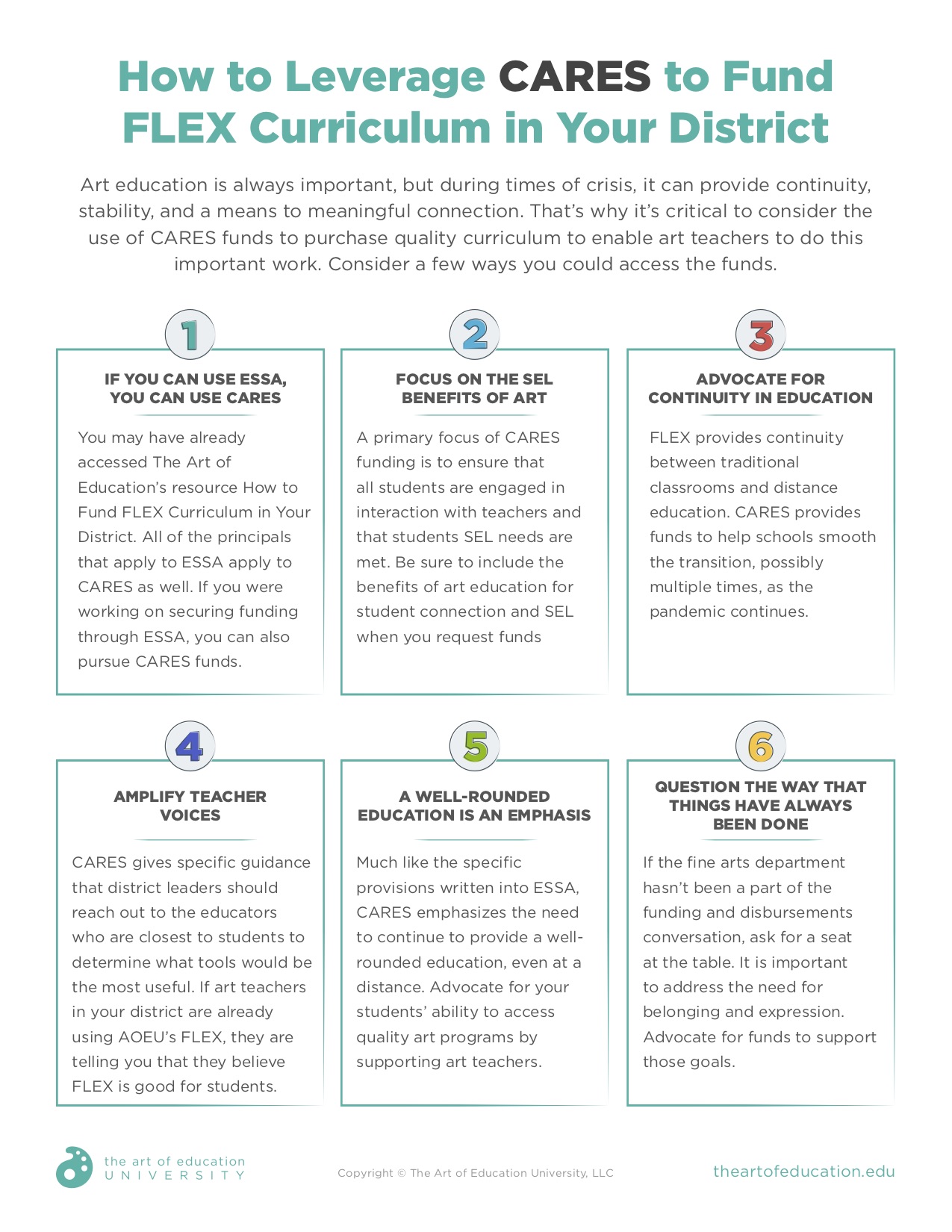Whenever art teachers hear about federal spending, our eyes often glaze over. We, quite honestly, have much too full of plates to dig through the details of the various initiatives that circulate. We’ve got students to help, artwork to create, and skills to improve. For better or worse, we think that big federal dollars simply don’t apply to us and what we can provide for our students.
However, we are at a unique point in history. The coronavirus has changed everything. Due to changes across the board, you might have heard of the CARES Act. The CARES Act has become known for its aid to small businesses, the Paycheck Protection Program, large job industries, and not so much for education.
However, the CARES Act is for education—you just haven’t heard about it yet.
What is the CARES Act?
In late March 2020, an over $2 trillion economic relief package, the Coronavirus Aid, Relief, and Economic Security (CARES) Act, was passed by Congress with overwhelming, bipartisan support and signed into law. This federal spending will help ease the burden and change due to the impacts of COVID-19 the past few and future months will bring millions of Americans, including K-12 schools.

How does the CARES Act apply to K-12 Education?
As you know, the coronavirus has upended the way schools are operating, but the pain of this year will most likely continue into next. This is due to tax revenue losses projected for the future. Essentially, the total aid in the CARES Act earmarked for education is about $30.7 billion. Within that, $13.2 billion is set aside for K-12 education. Of course, there are stipulations to how the funds can be spent. However, due to the quick nature and necessity of the bill, the requirements of receiving the funds come without the typical and tedious earmarks and at a much faster pace.
How are the CARES Act funds decided?
State governors must apply for the funding. Once approved, they can start spending. States are given the same percentage in which they already receive Title funds. As a result, States and districts can have a pretty accurate idea as to how much of the CARES Act funding they will receive.
What will the CARES Act funds be used for?
While there are specifics, in a nutshell, the funds used must increase the equity in education. The biggest dollars will most likely be spent on purchasing educational technologies to support online learning. Many districts will try to take advantage of these funds and purchase things they have long wanted (Learning Management Systems/One-to-One Devices/Accessible Curriculum Software), but would not be able to afford or justify with other funding.
How can the CARES Act especially benefit art education?
It has never been more clear that art teachers are essential workers of the school. During this time of online learning, students are connecting with art not because they need to, but because they want to. You are the hook encouraging students to check-in, stay engaged, and get excited about learning. Art education and teachers have adapted quickly and evolved with the needs of students. The fact is, you are used to pivoting. Art educators are guiding students through social and emotional learning, submitting AP portfolios, and hosting weekly Zoom meetings. You are actively strengthening the connection between home and school.

In essence, during this time or in the future of online learning, anything an art teacher does, needs, or uses to connect with students can be supported by the CARES Act. The bill states, “Purchasing educational technology (including hardware, software, and connectivity) for students who are served by the local educational agency that aids in regular and substantive educational interaction between students and their classroom instructors, including low-income students and students with disabilities, which may include assistive technology or adaptive equipment” (pg. 759, lines 13-20) falls under the qualifications of funding.
How can you use the CARES Act to YOUR benefit?
CARES Act funding is ripe for the picking. You and your program are living proof that you “aid in regular and substantive interaction between students and their classroom instructors.” This means you can and should ask for funding. Start with your principal or director, and they can help you speak to higher administration or the board. This information should empower you to ask and advocate for what you need now. Use the language and knowledge of the bill as tools for your toolbox. Now is also when you should be thinking about your own professional development and accessible curriculum and how the CARES Act funding can apply.
How and why the CARES Act can cover FLEX Curriculum and PRO Learning:
AOEU’s FLEX Curriculum and PRO Learning are exactly what you need to continue teaching and learning to the highest degree, and they can be covered by the CARES Act. Perhaps you thought since your curriculum cycle is passed, you cannot request FLEX Curriculum. Or that you already spent professional development funds to attend a conference earlier this year, and PRO Learning is not an option. With the CARES Act, you can. It opens the window you thought might be closed.
Introducing FLEX Curriculum by The Art of Education University
How to Ask Your Administrator to Pay for Art Ed PRO
With its almost forty Lesson Collections, FLEX Curriculum allows students and teachers to communicate, collaborate, and create artwork based on the National Core Art Standards. It is also completely accessible online. Teachers can post lessons, resources, and videos from FLEX directly on a Learning Management System (LMS). The platform is easy to navigate for students, teachers, and parents.
PRO Learning can show you how to move your classroom and curriculum online and allows you to grow as a teacher for your students regardless of the circumstance. By covering a variety of important topics such as Social-Emotional Learning, Flipping Your Classroom, Infusing Technology Into Your Practice, and Enhancing Artworks with Digital Integration, you will sharpen your abilities as a teacher, and thus better address the creative needs of your students.
Use this helpful download when speaking to your administrator:
What else is important to know about the CARES Act?
WATCH THE WEBINAR
Once states are approved for funding, they have to use the funds within twelve months. The sense of urgency to advocate for you, your program, and your students is paramount. In addition, the funds are “use or lose.” This means states and districts will spend the funds regardless of the needs. Often, districts and administrators are not sure what you as the art teacher need. It is up to you to tell them. Just as you have shown up for your students this past year, you can do it again by requesting support from these funds.
What else do you need to know about the CARES Act?
How can AOEU support you with access to FLEX Curriculum and PRO Learning?
What is preventing you from asking your administrator for support from these funds?
Magazine articles and podcasts are opinions of professional education contributors and do not necessarily represent the position of the Art of Education University (AOEU) or its academic offerings. Contributors use terms in the way they are most often talked about in the scope of their educational experiences.






